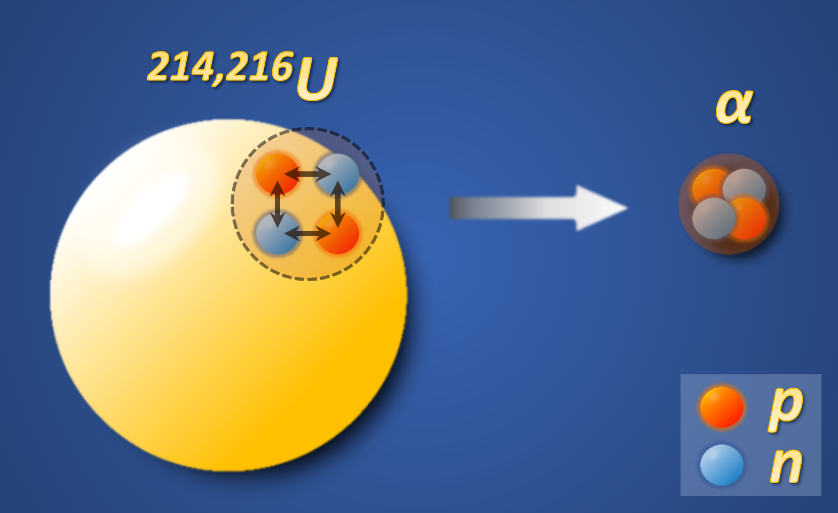Apr 19 2021
In nuclear physics research, the discovery of new isotopes with extreme proton/neutron numbers is always fascinating. The α-decay in the heavy nuclei region is one of the ubiquitous decay modes and has a crucial role in the search for new isotopes.
 The illustration of the enhanced α-particle preformation in 214,216U deduced by the strong proton-neutron interaction. Image Credit: Zhiyuan Zhang.
The illustration of the enhanced α-particle preformation in 214,216U deduced by the strong proton-neutron interaction. Image Credit: Zhiyuan Zhang.
But even after nearly a century of analyzing α-decay, researchers are still unable to perfectly explain how the α-particle forms at the nucleus surface before it is emitted.
During the α-decay process, the α-particle can be considered not just as two neutrons plus two protons but also as two neutron-proton pairs.
Earlier research works have demonstrated the significance of the pairing forces between the identical nucleons, but it is not clear to date whether the strong neutron-proton interactions have an effect on α-decay properties, specifically in the heavy nuclear region.
A study published in Physical Review Letters on April 14th, 2021, as an Editors’ Suggestion, has reported the observation of 214U—a new uranium (U) isotope—and has shown for the first time the strange enhancement of α-particle clustering in uranium isotopes.
The research was headed by researchers at the Institute of Modern Physics (IMP) of the Chinese Academy of Sciences (CAS). The team performed the experiments at the gas-filled recoil separator, Spectrometer for Heavy Atoms and Nuclear Structure (SHANS), at the Heavy Ion Research Facility in Lanzhou (HIRFL), China.
The researchers used the recoil-α correlation method and the SHANS separator to discover the new isotope 214U and accurately quantified the α-decay properties of 214,216,218U.
A well-known fact is that the interaction between valence neutrons and protons that occupy orbits with an equal number of nodes and orbital angular momenta results in several exotic changes of closed shells.
The nuclei near the magic neutron number N = 126 provide an ideal place to probe how nuclear structure changes influence α-decay properties.
Zhiyuan Zhang, Researcher, Institute of Modern Physics, Chinese Academy of Sciences
The α-decay reduced widths associated with the α-particle formation probability were extracted by the researchers for the even-even polonium-plutonium nuclei close to the N = 126 shell closure. Then, their systematic trends were discussed in terms of the NpNn scheme.
By combining the experimental data, “the behavior in the N < 126 region indicates that the strong proton-neutron interaction plays a crucial role in α-decay,” stated Zhang.
At the same time, a notable fact is that the reduced widths of 214,216U analyzed in this study are considerably improved by a factor of two with respect to the systematic trend for the N < 126 nuclei in the NpNn scheme.
This phenomenon could be due to the strong monopole interaction between the valence 1f5/2 neutrons and 1f7/2 protons together with a higher occupancy of the 1f7/2 proton orbit, verified by the large-scale shell-model calculations.
The findings of the study open up new avenues in an under-explored portion of the nuclide chart, where the α-particle is preformed with an increased probability and emitted at a quicker decay rate.
“As a possible preview of future studies in this region, it is expected that this effect might become even stronger in the plutonium isotopes. Thus, it is extremely intriguing to extend the decay-width systematics to higher-Z nuclei,” the study explains.
This study was financially supported by the Strategic Priority Research Program of CAS, the National Key R&D Program of China, and the National Natural Science Foundation of China, besides others.
Journal Reference:
Zhang, Z. Y., et al. (2021) New α-Emitting Isotope 214U and Abnormal Enhancement of α-Particle Clustering in Lightest Uranium Isotopes. Physical Review Letters. doi.org/10.1103/PhysRevLett.126.152502.